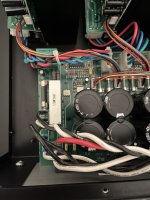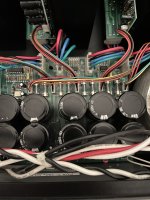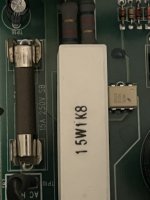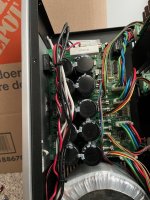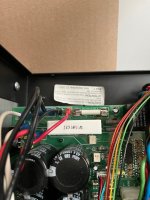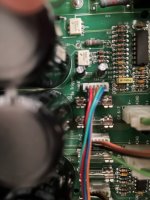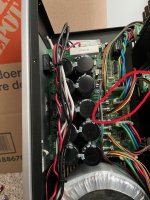I bought a used Anthem PVA-7 amplifier, knowing it was not working on 6 of the 7 channels. I have reversed engineered the working channel (no schematic) and have all 7-channels working. As I was cleaning it up, I got to looking at the fuses (only 4 rail fuses the other 4 were missing) and I have some reservations to their rating.
The main fuse coming in was a 15A fast-blow ceramic, but the board clearly states 15A slow-blow on the PCB - so I have changed to a 15A slow-blow ceramic fuse.
The power rails, +/-55Vdc, has a pair of fuses for each Heatsink (three heatsinks have 2 channels and the Center is a single channel on a heatsink). In the amplifier the Center (single channel h/s) and one of the Dual channel h/s boards came with 15A fast-blow ceramic fuses. I question the amperage and being fast-blow type, not to mention they look brand new (red flag). While I was repairing and testing to make sure I fixed everything, I used 6.3A slow-blow fuses. No trouble but I have only repaired and tested/listened at low volumes up to this point and I don't want to blow single/both fuse(s) when I give it a real test.
Any one know the specific amperage/style rail fuses that should be installed? Are the 15A fast-blow ones correct? The amp has speaker, over current and voltage protection so the fuses seem to be there in case of catastrophic failure in one or both of the rails.
The amp is a 2-pair (2SA1302/2SC3281) TO-264 output per channel and I currently have it biased at ~25mA per channel and the h/s is slightly above room temp. after 2 hours of low volume music (~5 watts), with no more than 10mV of DC offset, running at +/-55V rails, with a 40-0-40 Vac rated at 8.8A transformer.
The main fuse coming in was a 15A fast-blow ceramic, but the board clearly states 15A slow-blow on the PCB - so I have changed to a 15A slow-blow ceramic fuse.
The power rails, +/-55Vdc, has a pair of fuses for each Heatsink (three heatsinks have 2 channels and the Center is a single channel on a heatsink). In the amplifier the Center (single channel h/s) and one of the Dual channel h/s boards came with 15A fast-blow ceramic fuses. I question the amperage and being fast-blow type, not to mention they look brand new (red flag). While I was repairing and testing to make sure I fixed everything, I used 6.3A slow-blow fuses. No trouble but I have only repaired and tested/listened at low volumes up to this point and I don't want to blow single/both fuse(s) when I give it a real test.
Any one know the specific amperage/style rail fuses that should be installed? Are the 15A fast-blow ones correct? The amp has speaker, over current and voltage protection so the fuses seem to be there in case of catastrophic failure in one or both of the rails.
The amp is a 2-pair (2SA1302/2SC3281) TO-264 output per channel and I currently have it biased at ~25mA per channel and the h/s is slightly above room temp. after 2 hours of low volume music (~5 watts), with no more than 10mV of DC offset, running at +/-55V rails, with a 40-0-40 Vac rated at 8.8A transformer.
Attachments
Anyone have thoughts on fuse rating and style needed? Are the 15A FB ones in the amp correct, or should they be slow-blow and what amperage? Also, does anyone know the proper bias setting for this 2-pair BJT TO-264 output stage? Would like to know the manufacturer's specified mV, or mA setting?
The ratings should always be specified on the PCB somewhere. Ideally you would need to get the service manual and find out the part numbers for the fuses. Even fuses with the same ratings from different manufacturers can have wildly different characteristics.
I wish it was on the PCB somewhere, but it’s not for the rail fuses, only the transformer secondary input to the supply board.
I have searched for an Anthem service manual, but there are none for any models they make that I can find on the web.
I have searched for an Anthem service manual, but there are none for any models they make that I can find on the web.
Follow-up in case someone needs this information down the road - emailed Anthem tech support and they responded with...
- main fuse is 15A 6x30 MDA fuse (same as what's written on the PCB)
- rail fuses are 10A 5x20 fast-blow fuses (8). Do not specify glass or ceramic, but some pictures on the internet suggest they are glass, but could be wrong.
- main fuse is 15A 6x30 MDA fuse (same as what's written on the PCB)
- rail fuses are 10A 5x20 fast-blow fuses (8). Do not specify glass or ceramic, but some pictures on the internet suggest they are glass, but could be wrong.
Hi @bullittstang thanks for posting the follow up. I face almost a similar situation. I have a PVA7. All channels were working fine. One day while the amplifier was on, I accidently shorted speaker cables for surround L/R channels (one or both I am not sure). I heard a pop. Since then I hear no sound from the surround left and right channels. All other remaining 5 channels are working fine. From the back layout of the input/output terminals of PVA7 it looks like left and right surround channels are on the same amp board/heatsink. From your investigation it looks like I have a blown fuse as well. What do you think? I would like to start there first. I have a question. How many fuses I am looking to replace to fix left and right surround channels if they are on the same board? Are they located on the amp module that is attached to the heatsink or on the power supply board and how to identify which one it is? And from the rating from your description, it looks like they will be 10A 5x20 fast-blow fuses. Is it easy to open the chassis an replace the fuse? Thanks.
1) Yes, Left & Right Surround channels are on a single PCB sharing a single heatsink.
2) Unlikely that shorting the speaker cable is only fuses - but fingers crossed it is.
3) Each channel requires 2 10A 5x20 fast blow fuses (one for positive voltage rail, one for negative voltage rail) - all fuses are on the PSU board, so you don't need to remove and heatsinks/PCBs to check/replace them.
4) Yes pretty easy - just take the 8-12 screws out of the top cover (top and sides) and lift off, careful not to scratch anything. Then making sure you have waited at least 15-20 mins for Caps to discharge or you will best cast blow more fuses, worse case electrocute yourself. You can test by putting your DMM negative to any speaker negative (black) and touching the red probe to both ends of each fuse. You will see positive voltage on one fuse and negative voltage on the other fuse. Do not mess with anything if this voltage is greater than 1-2 Vdc.
Then using a non-metal object (chopstick) you can pop out the old fuses, check them to see if they are in fact blown and then replace as needed.
Warning if they are blown, there is still a chance they will blow immediately again when you power up the unit. Use a DBT or Variac if you have one, otherwise keep you hand on the power cord and be ready to unplug if anything looks or smells suspicious.
Below is a a few pics - so you know what to look for. I would also check the 15A main fuse, but not necessary if other channels are working.
2) Unlikely that shorting the speaker cable is only fuses - but fingers crossed it is.
3) Each channel requires 2 10A 5x20 fast blow fuses (one for positive voltage rail, one for negative voltage rail) - all fuses are on the PSU board, so you don't need to remove and heatsinks/PCBs to check/replace them.
4) Yes pretty easy - just take the 8-12 screws out of the top cover (top and sides) and lift off, careful not to scratch anything. Then making sure you have waited at least 15-20 mins for Caps to discharge or you will best cast blow more fuses, worse case electrocute yourself. You can test by putting your DMM negative to any speaker negative (black) and touching the red probe to both ends of each fuse. You will see positive voltage on one fuse and negative voltage on the other fuse. Do not mess with anything if this voltage is greater than 1-2 Vdc.
Then using a non-metal object (chopstick) you can pop out the old fuses, check them to see if they are in fact blown and then replace as needed.
Warning if they are blown, there is still a chance they will blow immediately again when you power up the unit. Use a DBT or Variac if you have one, otherwise keep you hand on the power cord and be ready to unplug if anything looks or smells suspicious.
Below is a a few pics - so you know what to look for. I would also check the 15A main fuse, but not necessary if other channels are working.
Attachments
Thank you so much for your response. Just 2 more dumb questions, the fuses I checked on the internet show 250v for example "CompStudio Pack of 10 Fast Blow Fuse 10 Amp 250V 5 X 20MM Glass F10AL250V" from Amazon. https://www.amazon.ca/CompStudio-Pa...lpcontext&ref_=fplfs&psc=1&smid=AFODAAFTCHV5Y
Do they seem the right one?
Also on the PCB it mentions channel numbers like CH 6-7 it does not say Surround channels or main etc. Would you know which channel numbers would correspond to Surround left and right channels?
Thanks again.
Do they seem the right one?
Also on the PCB it mentions channel numbers like CH 6-7 it does not say Surround channels or main etc. Would you know which channel numbers would correspond to Surround left and right channels?
Thanks again.
In addition to the above, I saw 125v version of the fuses as well. I am based in Canada so I think it would be 125v
https://www.amazon.ca/SIXQJZML-F10A...20+fast+blow+fuses,industrial,220&sr=1-4&th=1
https://www.amazon.ca/SIXQJZML-F10A...20+fast+blow+fuses,industrial,220&sr=1-4&th=1
the voltage just needs to be greater than the voltage in your Region: US = 120-125Vac and Europe = 220-240Vac to cover both Regions with a single fuse - so yes, those should be fine.
2) R/L Surround in my amp is labelled as Channel 4/5, but you just need to follow the small gauge (thinner) wires, 6 multi-colored which plugs directly below the CH 4/5 or CH 2/3 or CH 6/7 designator. It might be different then mine if someone plugged that board into a different CH on the PSU - does not matter as long as the wire connection(s) will reach. See attached image.
2) R/L Surround in my amp is labelled as Channel 4/5, but you just need to follow the small gauge (thinner) wires, 6 multi-colored which plugs directly below the CH 4/5 or CH 2/3 or CH 6/7 designator. It might be different then mine if someone plugged that board into a different CH on the PSU - does not matter as long as the wire connection(s) will reach. See attached image.
Attachments
- Home
- Amplifiers
- Solid State
- Anthem PVA-7 - Fuse rating
